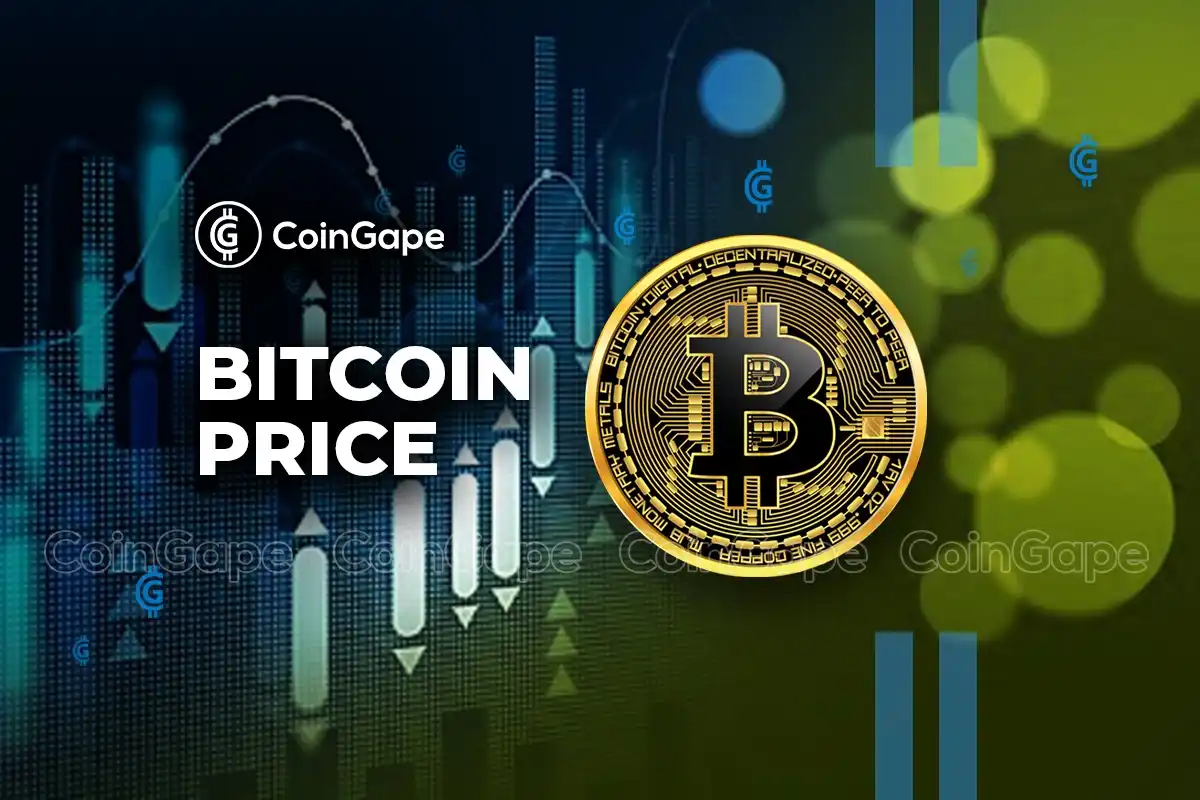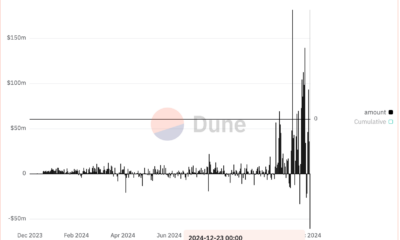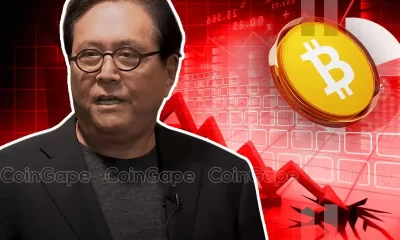24/7 Cryptocurrency News
5 Things To Expect from Bitcoin Price Based on Historical Trends
Published
3 months agoon
By
admin
Historical trends have always been used to analyze Bitcoin price and provide insights into the crypto’s future trajectory. Although these trends don’t always play out the same way, they tend to rhyme and give a pattern, indicating what to expect from the leading crypto. In line with this, there are certain things to expect from BTC heading into the fourth quarter of this year and 2025.
Bitcoin Price To Benefit From Rate Cuts
Bitcoin price is set to benefit from the rate cuts projected to begin at the next FOMC meeting, which will be held between September 17 and 18. Historically, rate cuts by the US Federal Reserve have been considered bullish for BTC since this quantitative easing (QE) leads to an increase in the money supply, with investors having more capital to spend on risk assets like Bitcoin.
The Fed’s last rate cut came in March 2020, marking the beginning of a bull run for the flagship crypto, which rose to an all-time high (ATH) of around $69,000 in November 2021. When the rate cut happened, BTC was trading at around $7,000. As such, something similar could play out again, especially with its price expected to peak by year-end 2025.
Three Consecutive Green Months In Q4
Bitcoin could enjoy three consecutive green months in the last quarter of this year. Coinglass’ data shows that the flagship crypto has historically enjoyed positive monthly returns in October, November, and December in the previous two halving years. This halving event again occurred this year, meaning that the coin could finish the last three months of this year in the green.


Another reason crypto natives are confident that this historical trend could play out this way is how the crypto has performed this month. September has often been bearish for BTC, and this month has been no different. As such, this indicates that Bitcoin price still mimics past trends and could replicate its historical Q4 performance in the 2016 and 2020 halving years.
A Price Rally After The US Elections
A price rally is imminent for BTC after the US elections in November. This happened in the last two presidential elections in 2016 and 2020. Although Bitcoin wasn’t a major talking point ahead of those previous elections like it is now, the certainty that the aftermath of the election brings is constant. Market participants love certainty and will be able to deploy more capital to these risk assets after the election.
It is worth mentioning that experts like Bernstein analysts predict that Bitcoin price will rise to $90,000 if Donald Trump wins the election. However, Steven Lubka, the Head of private clients and family offices at Swan Bitcoin, argues that Bitcoin is rooted in countries’ fiscal and monetary profiles and that the leading crypto will perform positively irrespective of who wins.
Year-End 2025 Could Market Peak For Bitcoin Price
BTC’s price is expected to peak by year-end 2025 based on its halving cycle, which forms part of its four-year cycle. The crypto asset faces two years of bear and bull markets during this four-year cycle. The halving cycle usually marks the start of the bull market, which begins after the halving event. BTC enjoys notable price surges and peaks 16 to 18 months after the halving.
Crypto analyst Rekt Capital’s analysis highlighted how Bitcoin peaked 518 days after the 2016 halving and 546 days after the 2020 halving. If history were to repeat itself, the crypto asset’s price would peak in this cycle in September or October 2025.
The Mars-Vesta Cycle theory, which aligns with Bitcoin’s four-year cycle, also indicates that the market peak for BTC could come in October 2025. Bitcoin price is expected to reach $100,000 by then or even higher.
Massive Price Rally Following Golden Cross
Crypto analyst Titan of Crypto revealed in an X post that a Golden Cross had appeared on Bitcoin’s chart. In past cycles, BTC enjoyed a “massive” price rally whenever this bullish signal appeared on its chart. This indicates that a price surge might be imminent, especially with the rate cuts and given its historical Q4 performance.
Despite Bitcoin having a bullish outlook based on these historical trends, the US economy’s frail state still poses a threat to any price surge BTC is set to enjoy. A short-term or long-term contraction could invalidate these historical trends and lead to a bearish outlook for Bitcoin price. As such, the macro side is still one to keep an eye on.
Boluwatife Adeyemi
Boluwatife Adeyemi is a well-experienced crypto news writer and editor who has covered topics that cut across DeFi, NFTs, smart contracts, and blockchain interoperability, among others. Boluwatife has a knack for simplifying the most technical concepts and making it easy for crypto newbies to understand. Away from writing, Boluwatife is an avid basketball lover and a part-time degen.
Disclaimer: The presented content may include the personal opinion of the author and is subject to market condition. Do your market research before investing in cryptocurrencies. The author or the publication does not hold any responsibility for your personal financial loss.
Source link
You may like


Most Layer 2 solutions are still struggling with scalability


Here’s why Stellar Price Could Go Parabolic Soon


Perp-Focused HyperLiquid Experiences Record $60M in USDC Net Outflows


Experts say these 3 altcoins will rally 3,000% soon, and XRP isn’t one of them


Robert Kiyosaki Hints At Economic Depression Ahead, What It Means For BTC?


BNB Steadies Above Support: Will Bullish Momentum Return?
24/7 Cryptocurrency News
Robert Kiyosaki Hints At Economic Depression Ahead, What It Means For BTC?
Published
6 hours agoon
December 23, 2024By
admin
Rich Dad Poor Dad author Robert Kiyosaki has issued a stark warning while hinting towards an economic depression ahead. In a recent X post, the renowned author said that the global market crash has already started, as he predicted earlier, which indicates that the financial market might enter a “depression” phase. Notably, this comes as the crypto market records immense volatility, sparking concerns over what’s next for Bitcoin (BTC).
Robert Kiyosaki Hints At Economic Depression Ahead
Robert Kiyosaki, in a recent X post, has revealed a stark warning of a looming economic depression. The Rich Dad Poor Dad author warned that a global market crash has already begun, citing Europe, China, and the U.S. as regions facing significant downturns.
In his post, Kiyosaki urged caution, advising individuals to safeguard their finances and maintain their jobs. “Global crash has started. Europe, China, USA going down. Depression ahead?” he asked while emphasizing the enduring value of assets like gold, silver, and Bitcoin. He added, “For many people, crashes are the best times to get rich.”
This warning aligns with Kiyosaki’s earlier prediction of what he called the “biggest crash in history.” Earlier this month, he encouraged his followers to prepare for financial turmoil, stating, “Please be proactive and get rich… before the BOOMER’s go BUST.”
However, this recent comment from Robert Kiyosaki indicates his sustained confidence in BTC. As the crypto market faces heightened volatility, Bitcoin could emerge as a hedge against traditional market instability, he noted. Besides, it also indicates that the flagship crypto, alongside gold and silver, might continue to gain traction amid this economic turmoil.
What’s Next For BTC?
Bitcoin price today has continued its volatile trading, losing nearly 1.5% over the last 24 hours to $95,323. The crypto touched a high and low of $97,260 and $93,690 in the last 24 hours, showcasing the highly volatile scenario in the market.
In addition, the US Spot Bitcoin ETF also recorded significant outflow, with BlackRock Bitcoin ETF witnessing its largest outflux since its launch. This has weighed on the investors’ sentiment, sparking concerns over a waning institutional interest.
However, despite that, many experts remained confident on the asset’s future trajectory. For context, in a recent X post, Peter Brandt shared a new BTC price target, indicating his confidence in the digital asset.
On the other hand, institutions like Metaplanet have also continued to boost their BTC holdings. These moves indicates that the institutions, as well as many investors, are bullish towards the long-term potential of the crypto. Besides, as Robert Kiyosaki said, the recent dip also provides a buying opportunity to investors, which might further boost Bitcoin to its new ATH ahead.
Rupam Roy
Rupam is a seasoned professional with three years of experience in the financial market, where he has developed a reputation as a meticulous research analyst and insightful journalist. He thrives on exploring the dynamic nuances of the financial landscape. Currently serving as a sub-editor at Coingape, Rupam’s expertise extends beyond conventional boundaries. His role involves breaking stories, analyzing AI-related developments, providing real-time updates on the crypto market, and presenting insightful economic news.
Rupam’s career is characterized by a deep passion for unraveling the complexities of finance and delivering impactful stories that resonate with a diverse audience.
Disclaimer: The presented content may include the personal opinion of the author and is subject to market condition. Do your market research before investing in cryptocurrencies. The author or the publication does not hold any responsibility for your personal financial loss.
Source link
24/7 Cryptocurrency News
Tron’s Justin Sun Offloads 50% ETH Holdings, Ethereum Price Crash Imminent?
Published
9 hours agoon
December 23, 2024By
admin
Tron founder Justin Sun has been heavily offloading his ETH holdings with Ethereum price crashing 17% following the rejection at $4,000. Over the past 7 days, Sun has offloaded another 50% of his holdings worth $143 million. Market analysts predict that ETH price could further take a dip below $3,000 once again before resuming upside momentum.
Tron’s Justin Sun on ETH Selling Spree
Justin Sun is on a massive Ethereum selling spree since the coin resumed its upward journey after Donald Trump’s election win. This continued even until last week, when Tron founder offloaded $143 million worth of ETH causing Ethereum price to tank over 15% amid the crypto market crash.
Blockchain analytics firm Spot On Chain reported that Justin Sun redeemed 39,999 ETH (valued at $143 million) from liquid staking platforms Lido Finance and EtherFi. He subsequently deposited the entire amount into HTX.
Since November 10, as Ethereum price has trended upward, Sun has deposited a total of 108,919 ETH (worth $400 million) to HTX at an average price of $3,674. Notably, many of these deposits occurred near local price peaks.


Spot On Chain also revealed that Justin Sun currently has 42,904 ETH (valued at $139 million) in the process of unstaking from Lido Finance. The Tron founder might potentially send this funds to HTX later.
Ethereum Price Drop Below $3,000 Coming?
With Ethereum price losing its crucial support of $3,500, the market sentiment for the world’s largest altcoin has turned bearish. Last week, crypto market analysts turned bearish on Ethereum expecting the ETH price to drop $2,800 on selloff by whales.
Popular market analyst IncomeSharks stated that it was a “low-volume weekend,” for Ethereum following a volatile week for stocks. The analysts added that it won’t be the right time to sell.
The On-Balance Volume (OBV) indicator, a tool used to gauge buying and selling pressure, remains steady, oscillating within a channel. Recent Ethereum buyers are still in profit, providing some support for the market. However, the below chart shows that there’s still scope for Ethereum to take a dip to $3,000.


Prominent crypto analyst “I am Crypto Wolf” also highlighted a bullish outlook with a potential inverse head-and-shoulders (iHS) pattern. According to the analyst, Ethereum price chart is currently forming the “right shoulder” of the iHS continuation pattern.


This setup could provide the momentum needed to surpass the $4,000 resistance and aim for a $10,000 target by May. A breakout is anticipated by the end of January, though a retest of the $3,000 level remains a possibility before the rally takes off, he noted.
Bhushan Akolkar
Bhushan is a FinTech enthusiast with a keen understanding of financial markets. His interest in economics and finance has led him to focus on emerging Blockchain technology and cryptocurrency markets. He is committed to continuous learning and stays motivated by sharing the knowledge he acquires. In his free time, Bhushan enjoys reading thriller fiction novels and occasionally explores his culinary skills.
Disclaimer: The presented content may include the personal opinion of the author and is subject to market condition. Do your market research before investing in cryptocurrencies. The author or the publication does not hold any responsibility for your personal financial loss.
Source link
24/7 Cryptocurrency News
CryptoQuant Hails Binance Reserve Amid High Leverage Trading
Published
15 hours agoon
December 23, 2024By
admin
Crypto analytics platform CryptoQuant has conducted a deep dive research into Binance and other centralized exchanges to uncover how susceptible they are to liquidity risks. With the crypto ecosystem trading at a very high premium, exchanges require high liquidity to meet growing demands. Of its findings, CryptoQuant singles out Binance and OKX as platforms to watch out for.
What Makes Binance Stand Out from Centralized Exchanges?
According to CryptoQuant, it analyzed the leverage levels of top centralized exchanges. It conducted this exercise to evaluate their liquidity, default risk and how crypto reserves backs trading activity. The analysis also employs leverage ratio calculation to estimate trader’s exposures.
Based on this, the analytics firm singled out Binance as an exchange with robust reserves. The trading platform maintains this reserve despite the significant growth in open interest this year. This is signficant, considering how Binance Futures list new tokens to fuel this expansion including Solana’s Fartcoin.
“Its reserves in Bitcoin, Ethereum, and USDT comfortably exceed its open interest. Binance also reported the lowest and most stable leverage ratio among major exchanges, with a ratio of 12.8 in December 2023, rising slightly to 13.5 in December 2024,” the CryptoQaunt report reads.
As pointed out, this stability and the 2.6x expansion in Bitcoin open interest on the platform from $4.45 billion to $11.64 billion implies that the exchange can handle unexpected liquidations.
Centralized Exchange Leverage Risk on the Midst of the Upcoming Bull Run
We assess the leverage levels of various crypto exchanges to evaluate their liquidity, default risk, and the extent to which their perpetual futures trading activity is backed by their crypto reserves.
Our… pic.twitter.com/NAadJSAlVT
— CryptoQuant.com (@cryptoquant_com) December 21, 2024
As the report hinted, smaller exchanges like OKX also maintain low leverage ratios.
Centralized Exchanges and Avoiding the FTX Saga
In addition to the Binance spotlight, CryptoQuant also mentioned Gate io, Bybit, and Deribit. However, the report noted that these trading platforms have the highest leverage ratios in the market pegged at 106, 86, and 32, respectively. Notably, this figures show open interests for Bitcoin and Ethereum is higher than the existing reserves available on these centralized exchanges.
The analysis concluded by flagging the impact of high leverage trading, one of the major causes of the FTX Derivatives Exchange collapse. This report serves as an eye opener that can help traders manage risk per platforms they trade on.
Meanwhile, FTX is at the tail end of its bankruptcy proceedings. As Coingape reported earlier, FTX has set January 3 as the date to commence creditor repayment.
Godfrey Benjamin
Benjamin Godfrey is a blockchain enthusiast and journalists who relish writing about the real life applications of blockchain technology and innovations to drive general acceptance and worldwide integration of the emerging technology. His desires to educate people about cryptocurrencies inspires his contributions to renowned blockchain based media and sites. Benjamin Godfrey is a lover of sports and agriculture.
Disclaimer: The presented content may include the personal opinion of the author and is subject to market condition. Do your market research before investing in cryptocurrencies. The author or the publication does not hold any responsibility for your personal financial loss.
Source link

Most Layer 2 solutions are still struggling with scalability

Here’s why Stellar Price Could Go Parabolic Soon

Perp-Focused HyperLiquid Experiences Record $60M in USDC Net Outflows

Experts say these 3 altcoins will rally 3,000% soon, and XRP isn’t one of them

Robert Kiyosaki Hints At Economic Depression Ahead, What It Means For BTC?

BNB Steadies Above Support: Will Bullish Momentum Return?

Metaplanet makes largest Bitcoin bet, acquires nearly 620 BTC

Tron’s Justin Sun Offloads 50% ETH Holdings, Ethereum Price Crash Imminent?

Investors bet on this $0.0013 token destined to leave Cardano and Shiba Inu behind

End of Altcoin Season? Glassnode Co-Founders Warn Alts in Danger of Lagging Behind After Last Week’s Correction

Can Pi Network Price Triple Before 2024 Ends?

XRP’s $5, $10 goals are trending, but this altcoin with 7,400% potential takes the spotlight

CryptoQuant Hails Binance Reserve Amid High Leverage Trading

Trump Picks Bo Hines to Lead Presidential Crypto Council

The introduction of Hydra could see Cardano surpass Ethereum with 100,000 TPS
182267361726451435

Why Did Trump Change His Mind on Bitcoin?

Top Crypto News Headlines of The Week

New U.S. president must bring clarity to crypto regulation, analyst says

Will XRP Price Defend $0.5 Support If SEC Decides to Appeal?

Bitcoin Open-Source Development Takes The Stage In Nashville

Ethereum, Solana touch key levels as Bitcoin spikes

Bitcoin 20% Surge In 3 Weeks Teases Record-Breaking Potential

Ethereum Crash A Buying Opportunity? This Whale Thinks So

Shiba Inu Price Slips 4% as 3500% Burn Rate Surge Fails to Halt Correction

Washington financial watchdog warns of scam involving fake crypto ‘professors’

‘Hamster Kombat’ Airdrop Delayed as Pre-Market Trading for Telegram Game Expands

Citigroup Executive Steps Down To Explore Crypto
Mostbet Güvenilir Mi – Casino Bonus 2024

NoOnes Bitcoin Philosophy: Everyone Eats
Trending

 3 months ago
3 months ago182267361726451435

 Donald Trump5 months ago
Donald Trump5 months agoWhy Did Trump Change His Mind on Bitcoin?

 24/7 Cryptocurrency News4 months ago
24/7 Cryptocurrency News4 months agoTop Crypto News Headlines of The Week

 News4 months ago
News4 months agoNew U.S. president must bring clarity to crypto regulation, analyst says

 Price analysis4 months ago
Price analysis4 months agoWill XRP Price Defend $0.5 Support If SEC Decides to Appeal?

 Opinion5 months ago
Opinion5 months agoBitcoin Open-Source Development Takes The Stage In Nashville

 Bitcoin5 months ago
Bitcoin5 months agoEthereum, Solana touch key levels as Bitcoin spikes

 Bitcoin5 months ago
Bitcoin5 months agoBitcoin 20% Surge In 3 Weeks Teases Record-Breaking Potential





✓ Share: